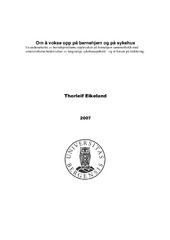| dc.description.abstract | Before as well as after the 2nd World war -, to put children into children’s homes was often the ultimate solution to the practical problem that was facing the social authorities when private care failed and mother and father proved incompetent. The incompetency might involve sickness and death, poverty, mental retardation, drug abuse and alcoholism, as well as violence and physical/psychical abuse. This remained so even if the first choice, according to Children’s Act of 1953, was fostercare. The actual period of institutionalization in this study runs from about 1940 to about 1980. The present study is one where 37 children from earlier children’s homes were interviewed about their daily life during their stay. This stay was supposed to last for at least 2 years. The actual range of stay was from 3 years to 19. The interviews were compared to those of 11 children who had been taken into hospital care in the first part of the period mentioned above, as the tuberculosis hospitals were settled in the midsixties. The children from the sanatoriums were chosen as a quasi-control group, as they were supposed to be the only group(except for the asthmatics and those with poliomyelitis1) which might match the situation of being removed from home; brought up by strangers for years, and having the least possible contact with their own parents or family. The main aim of the study was to bring to daylight the experiences of children in children’s homes. The second was to see if – when compared – the daily life of a children’s home might as well have been one lived in a sanatorium. If so, the national and international critique directed towards children’s homes might as well have been directed against hospitals and may be against any institution where children were brought up. If not so, may be these instituitons were built on quite different grounds developing attitudes and ways of handling children which were unrelated From unstructured interviews that lasted from one to four hours, the transcripts were searched for the most prominent themes of the daily lives of the children, in a manner inspired by the the Grounded theory approach. However, the children’s stories are presented narratively to illustrate the themes found, and as a result the comparison showed them to be more alike than different in the two institutions. This was a surprise but not unexpected. Rumours, written documents and autobiographies have indicated that the way children were handled in hospitals that accommodated patients for years resembled the routines that have been criticised in children’s public care. Thus we are faced with a reality that tells us that the criticised suppressive routines of institutional child care are not restricted to these institutions but have their parallel ways in hospitals as well. One troubling fact of this investigation was that the persons who seemed responsible for the import and maintenance of these suppressive routines were those in charge; the educated and the Christians among the staff. The people who had made a vow to serve their fellow men, more often than not, were those called “evil” by the children. This situation is explained on the background that hundreds of years with repressive upbringing have created people who do not recognize their tendencies to act violently when met with other people’s –especially children’s – resistance to the adult’s will. Thus we are caught in a stream of acts which overrides the pure cognitive knowledge that we have, telling us what to do and even overrides our ethical principles. Reference is made to the thoughts of Alice Miller. However, this goes not without saying that the children also met women who were described as nice and kind and observant to the children’s needs, and some children have responded: “she became my mother”. Another finding has been called “the collective blindness”; an expression that describes the situation when adult personnel recognize a colleague abusing a child without himself (the personel) acting. These situations have two typical consequences: a) the children, who always are aware of what is happening, lose their trust in the adult(s); and b) this kind of non-responsiveness is cementing these situations and thereby increasing the probability that they will reappear on the daily scene. Conclusively, lines are drawn to the impossibility of acting professionally when in close contact with patients or clients, without being trained to recognize the above mentioned mechanisms in your own mind. | en_US |
